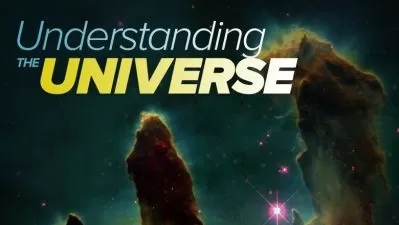Atomic, Nuclear & Particle Physics: From Beginner to Expert
Dr. Börge Göbel
16:42:49
Description
Models, experiments & equations: From quantum physics to radioactivity, nuclear decay, fusion, fission & standard model
What You'll Learn?
- Atomic physics: Experiments, equations, different models
- Nuclear physics: Models of the nucleus, stability of elements
- Radioactive decay processes, nuclear fission & nuclear fusion
- Particle physics: Standard model of elementary particles
- Fundamental properties: Mass, charge, spin & fundamental interactions: Gravity, electromagnetic, strong and weak interaction
- Advanced lectures: Quantum theory of the atom (Schrödinger equation with examples)
- Outlook: Molecular physics & solid-states physics
Who is this for?
What You Need to Know?
More details
DescriptionThis course is for everyone who wants to learn about atomic, nuclear & particle physics: Beginners to experts!
A bit of high school mathematics is all you need to know to get started!
One of the most fundamental questions of mankind is: 'What does matter consist of?'.
Today, we know it consists of atoms which consist of electrons and the nucleus. The nucleus can be subdivided into protons and neutrons which consist of quarks and other elementary particles. In this course we will follow the same history route from atomic physics to nuclear physics to particle physics.
We will discuss different models and the experiments that proved them wrong and motivated new models. Furthermore, we learn how nuclear reactions affect our everyday life and may satisfy our electricity demand in the future.
I can guarantee that you will learn a lot no matter what your current skill level is. The first sections are phenomenological and can be well understood by high school students. The last few section really go into the theoretical details and are on a university level.
You are kindly invited to join this carefully prepared course in which we derive the following concepts from scratch. I will present examples and have prepared quizzes and exercises for all topics.
Atomic physics (4.5 hours)
Classical atomic models:Â Dalton, Thomson and Rutherford models
Quantum atomic models: Bohr and Schrödinger models
Fundamental quantities & Interactions: Mass, charge, spin & Gravity, electromagnetic interaction
Nuclear physics (5.5 hours)
Models of the nucleus: Liquid-drop and nuclear-shell models
Fundamental interactions: Strong and weak interaction
Radioactivity & Nuclear decay reactions
Nuclear fusion & Nuclear fission
Particle physics (1.5 hours)
Standard model of particle physics
Quarks, Leptons, Gauge bosons, Higgs particle & Antimatter
Limits of the standard model & New approaches like quantum gravity or string theory
Theoretical background (4.5 hours)
Quantum mechanics: Schrödinger equation, Quantized energy spectrum, atomic orbitals
Relativity and quantum mechanics: Spin and spin-orbit interaction
Outlook: Molecular and Condensed-matter physics (1 hour)
Why me?
My name is Börge Göbel and I am a postdoc working as a scientist in theoretical physics. Therefore, I use presented concepts very often but I have not forgotten the time when I learned about it and still remember the problems that I and other students had.
I have refined my advisor skills as a tutor of Bachelor, Master and PhD students in theoretical physics and have other successful courses here on Udemy.
I hope you are excited and I kindly welcome you to our course!
Who this course is for:
- All skill levels from beginners to experts: The sections differ in difficulty from easy to advanced
- Everyone who wants to really understand what an atom is
- Students who want to understand the famous experiments and phenomena related to atomic and nuclear physics
- Know the current state of research: Standard model of particle physics and beyond
- The more advanced sections are especially for college and university students who are also interested in the mathematical description of the effects
This course is for everyone who wants to learn about atomic, nuclear & particle physics: Beginners to experts!
A bit of high school mathematics is all you need to know to get started!
One of the most fundamental questions of mankind is: 'What does matter consist of?'.
Today, we know it consists of atoms which consist of electrons and the nucleus. The nucleus can be subdivided into protons and neutrons which consist of quarks and other elementary particles. In this course we will follow the same history route from atomic physics to nuclear physics to particle physics.
We will discuss different models and the experiments that proved them wrong and motivated new models. Furthermore, we learn how nuclear reactions affect our everyday life and may satisfy our electricity demand in the future.
I can guarantee that you will learn a lot no matter what your current skill level is. The first sections are phenomenological and can be well understood by high school students. The last few section really go into the theoretical details and are on a university level.
You are kindly invited to join this carefully prepared course in which we derive the following concepts from scratch. I will present examples and have prepared quizzes and exercises for all topics.
Atomic physics (4.5 hours)
Classical atomic models:Â Dalton, Thomson and Rutherford models
Quantum atomic models: Bohr and Schrödinger models
Fundamental quantities & Interactions: Mass, charge, spin & Gravity, electromagnetic interaction
Nuclear physics (5.5 hours)
Models of the nucleus: Liquid-drop and nuclear-shell models
Fundamental interactions: Strong and weak interaction
Radioactivity & Nuclear decay reactions
Nuclear fusion & Nuclear fission
Particle physics (1.5 hours)
Standard model of particle physics
Quarks, Leptons, Gauge bosons, Higgs particle & Antimatter
Limits of the standard model & New approaches like quantum gravity or string theory
Theoretical background (4.5 hours)
Quantum mechanics: Schrödinger equation, Quantized energy spectrum, atomic orbitals
Relativity and quantum mechanics: Spin and spin-orbit interaction
Outlook: Molecular and Condensed-matter physics (1 hour)
Why me?
My name is Börge Göbel and I am a postdoc working as a scientist in theoretical physics. Therefore, I use presented concepts very often but I have not forgotten the time when I learned about it and still remember the problems that I and other students had.
I have refined my advisor skills as a tutor of Bachelor, Master and PhD students in theoretical physics and have other successful courses here on Udemy.
I hope you are excited and I kindly welcome you to our course!
Who this course is for:
- All skill levels from beginners to experts: The sections differ in difficulty from easy to advanced
- Everyone who wants to really understand what an atom is
- Students who want to understand the famous experiments and phenomena related to atomic and nuclear physics
- Know the current state of research: Standard model of particle physics and beyond
- The more advanced sections are especially for college and university students who are also interested in the mathematical description of the effects
User Reviews
Rating
Dr. Börge Göbel
Instructor's Courses
Udemy
View courses Udemy- language english
- Training sessions 161
- duration 16:42:49
- Release Date 2023/08/19











